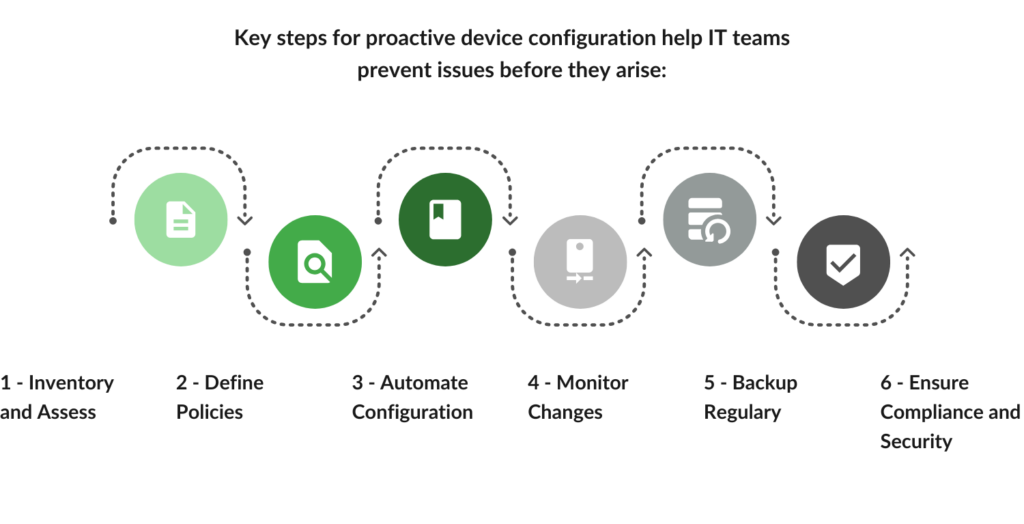Step-by-Step Guide to Device Configuration and Management for IT Teams

Introduction
Device configuration management consistently maintains a product’s functionality and performance quality throughout its shelf life by making timely reconfigurations to its internal systems.
Configuration Management (CM) helps prevent undocumented changes from entering the environment. This can prevent performance issues, system inconsistencies, and compliance issues that can lead to regulatory fines and penalties. This post provides a comprehensive step-by-step guide for IT teams’ device configuration and management.
What is Device Configuration Management?
Definition and Overview
Device configuration is the process of managing and maintaining consistency across all devices within a network. It Includes settings, policies, security configurations, and updates.
Importance of Configuration Management
Configuration management is essential for organizations because it ensures devices function correctly and securely. Helping IT teams manage complex environments reduces downtime, enhances security, and improves network performance.

Step 1 – Inventory and Assess Devices
Importance of Device Inventory
Understanding what devices are connected to your network, such as servers, switches, routers, etc., is also critical and can be more challenging than it may seem. In particular, it’s often the devices you don’t know you have that access business data, which penetration testers and bad actors like to pick up on. Using configuration management tools helps detect devices and collect this data.
How to Perform a Device Audit
Here are a few key steps to conduct a thorough device audit:
- Identify the type, location, and status of each device
- Regular audits to keep the inventory up to date
- Tools and software options to streamline the process
Step 2 – Define Configuration Policies
Setting Standard Configuration Policies
The second step is to define standardized configurations for all devices based on business needs and security requirements. By all devices, we mean the entire network—every router, switch, load balancer, firewall, virtual network device, or cloud-native network service. Network teams will suffer from continued organizational inefficiencies and potential security risks without consistent application to the whole network.
Security and Compliance Considerations
It’s essential to ensure that your configuration policies comply with industry regulations, such as GDPR and HIPAA, and that security patches and updates are applied uniformly across devices.
Creating Policy Templates
Whether you manage Apple (iOS and macOS) or Android devices, Policy Templates can be used to make your life easier. They are a hassle-free way to configure devices with pre-designed templates and streamline configuration management for similar devices.
Step 3 – Implement Automated Configuration Management Tools
Choosing the Right Tool
Configuration management tools automate the management and tracking of your IT infrastructure. Teams use these tools to help provision, configure, and deploy software and hardware resources across diverse environments. Some popular tools are ManageEngine, Spiceworks, and Puppet. When choosing a tool, some key features to look for are capabilities around automation, monitoring, reporting, backup, and restore functions.
Benefits of Automation
Experts consider business automation to be the future of work. Business automation is leveraging technological advances to remove critical processes and workflow bottlenecks. Businesses that embrace automation within their device configuration process will enjoy a competitive edge and benefit from the following:
- Reduces human error
- Speeds up deployment and reduces downtime
- Centralized control of configurations across the network
Step 4 – Monitor Configuration Changes
Importance of Monitoring and Tracking Changes
Change tracking and controlled change ensure a record of a system’s state. If issues arise, the cause can be linked to the effects. Tracking all configuration changes in real time ensures compliance, minimizes risk, and quickly detects unauthorized changes or misconfigurations.
Implementing Real-Time Alerts
When specific events occur on a device, setting up alerts for critical changes that could affect security or performance can help you be sure that no security events are missed. By using monitoring tools to provide reports and logs for analysis, your team can detect potential issues early and address them before they escalate by continuously monitoring device performance.
Step 5 – Regular Backup and Recovery
Importance of Backup for Device Configurations
Device backup and recovery involve creating and restoring copies of data from devices. Backup refers to saving data to another location, such as a cloud service, an external hard drive, or a network server. Recovery refers to retrieving data from the backup location in case of data loss or damage. It ensures that configurations can be restored quickly in case of failure.
By backing up and recovering your data, you can prevent data loss, minimize downtime, and maintain business continuity.
How to Set Up Automated Backups
Depending on the type of device, operating system, data format, and backup location, various methods and tools can back up device data. Cloud backup is a popular option involving using a cloud service like OneDrive to store data online.
Another option is on-premise device backup, which stores copies of business data and files on an external device such as a USB flash drive or an external hard drive.
Lastly, hybrid backup combines cloud and external methods to store data in multiple locations.
The key to setting up automated backups is scheduling regular backups for all network devices. Based on business needs, the choice between cloud-based or on-premise backup solutions should be made.
Restoration Process
Once your configurations are backed up, you can recover them immediately and use them to restore network devices during downtime. Labeling device configurations helps you distinguish them, making it easier to find a particular configuration.
Step 6 – Compliance and Security Audits
Conducting Regular Audits
IT must have a program to audit all devices to protect corporate data and prevent security incidents. By scheduling periodic security audits to identify potential vulnerabilities, your organization can ensure configurations remain compliant with internal and external standards.
Use of Audit Reports
Audit Report provides a snapshot of your device configurations on the network. By leveraging audit data, you can improve configuration policies and address gaps. Audit reporting tools help create actionable insights based on whether your device configurations meet your organization’s requirements in compliance policies.
Conclusion
Proactive device configuration is a strategy that allows IT professionals to stay ahead of potential issues. As a recap, this approach involves the following steps:
- Inventory and Assess Devices
- Define Configuration Policies
- Implement Automated Configuration Management Tools
- Monitor Configuration Changes
- Regular Backup and Recovery
- Compliance and Security Audits.
Proactive device configuration is crucial for maintaining network performance and security. It enables organizations to anticipate and address issues before they escalate, reducing system downtime and simplifying management.
Explore more on:





